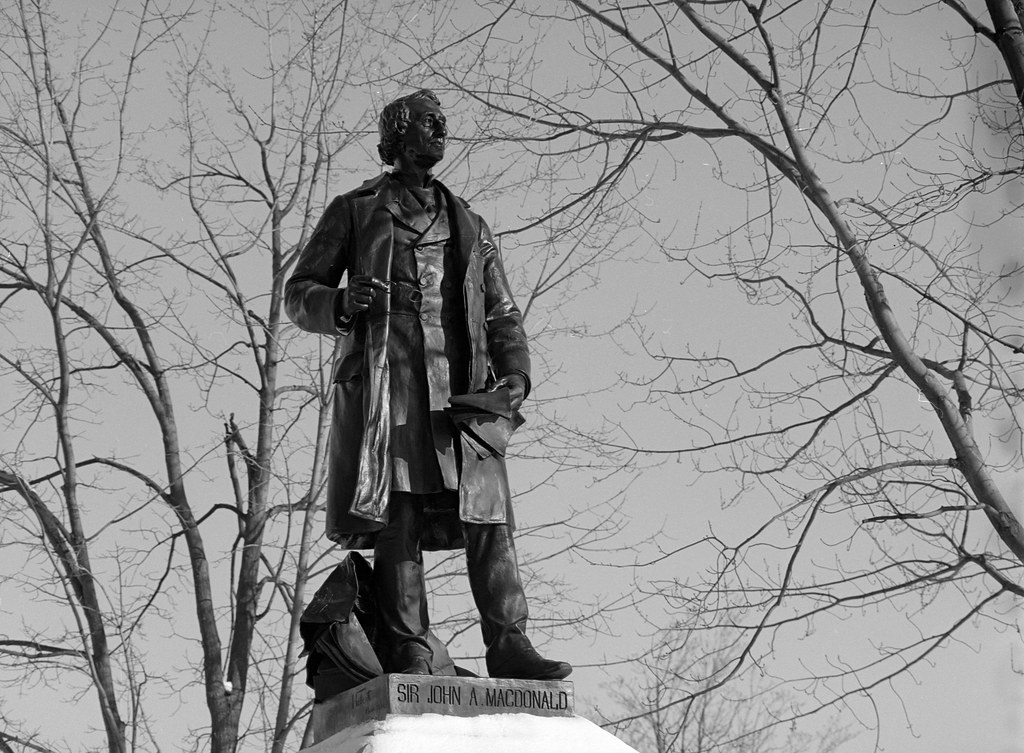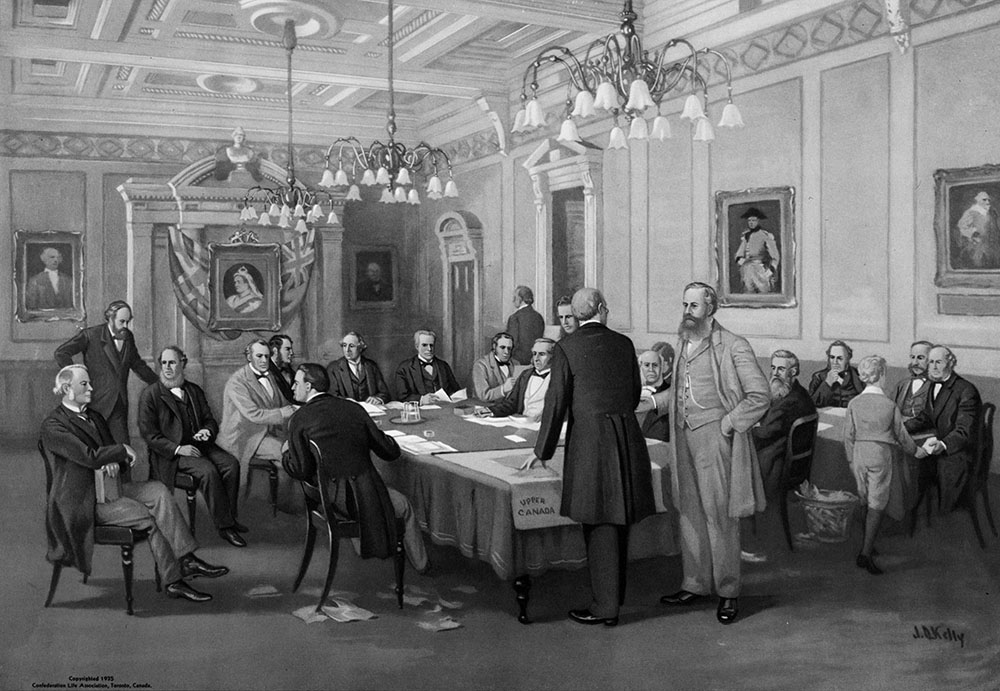If you’re wondering what everything has been leading up to this is it, we’re in the end game now. The road to Canadian Confederation is a long and rough one, with many false starts, failures to push through and roadblocks along the way. From the cause for political reform in the 1820s the rebellions of the 1830s. In through the victory of reform in the 1840s and the rocky roads in the 1850s. The threats to Canadian territory through invasion or annexation, it all leads to this, confederation. Despite the momentum in the aftermath of the Charlottetown and Quebec Conferences in 1864, the passage of the resolutions nagged at the provincial parliaments. They failed outright in Prince Edward Island who was more than happy to continue as a province of the Empire. In Nova Scotia, the resolutions passed, but the government now faced a rise in anti-confederation sentiment centred around Joseph Howe and with an election in 1867, the Premiere, Charles Tupper, began to raise the alarm. New Brunswick had a sudden reversal when their anti-confederation movement saw an election victory taking power. While they were ready to stop the resolutions from coming up for a vote, their government fell in a confidence vote, and Samuel Tulley’s government reelected and the resolutions passed. Canada, however, proved a tough sell. Despite everyone knowing that only a wider union could resolve the ongoing deadlock issue that continued to threaten overhead, many were still unsure of the whole scheme. George Brown would leave the Coalition over matters of leadership but would continue to support and promote the idea of Confederation. And while the resolutions passed, Canada East and Canada West continued to haggle over the divorce of the two areas of the province into individual provinces under the new Confederation. Combined with the Fenian Raids of 1866, John A MacDonald had started drinking again.

Mamiya m645 – Mamiya-Sekor C 45mm 1:2.8 N – Ilford FP4+ @ ASA-100 – Kodak D-23 (Stock) 6:00 @ 20C
The trouble was that all the provinces had agreed to meet on July 1866 in London to present their scheme to the Colonial Office and Parliament. And while Tupper and Tulley along with their delegates had arrived on time, the Canadians had not. This left the maritime parties in an embarrassing place, being unable to do anything to further confederation until the Canadians arrived. To make matters worse, Joseph Howe had also arrived in London and began to spread his anti-confederation propaganda around Parliament and the Colonial Office. And while the scheme met with strong support from the British Parliament, the government was on shaky ground when the draft bill failed to pass the first reading in the House of Commons. It took both the efforts of Tupper and Sir Charles Monck to get MacDonald sober and dry out and get back on track. If he did not, the whole thing would collapse. John A MacDonald and George Cartier along with their delegation, would arrive by November. Of course, MacDonald quickly addressed the issue of Howe, by convincing the group to total secrecy around their discussions; in fact, there would not be even minutes taken at the meetings. To aid in making up for the lost time, MacDonald also wanted little change made to the Quebec Resolutions. But the other delegates felt it was their duty to improve upon them to get the best deal possible for the people they represented. Archbishop Connelly from Nova Scotia wanted the same protections for Religious Minority education, and Alexander Galt wanted similar protections from the English minority in Quebec. The Maritimes also desired more from the Federal Subsidy to the smaller provinces. And no one could agree on how binding these resolutions were and if they needed to be ratified before moving forward on Confederation. A compromise would have to be reached, and if they could agree to each one in principle, the details could be hammered out afterwards. MacDonald’s art of negotiating earned him a good reputation among the politicians and bureaucrats who worked with the Canadians. Sir Fredric Rodgers, a Colonial Office liaison, would call MacDonald a ruling genius during the conference and the Colonial Secretary Lord Carnarvon described him as the ablest politician in Upper Canada. Even Howe couldn’t touch MacDonald, despite trying to use the Premiere’s drinking against him.

Mamiya m645 – Mamiya-Sekor C 150mm 1:3.5 N – Ilford HP5+ @ ASA-200 – Pyrocat-HD (1+1+100) 9:00 @ 20C
And while the political aspects took over much of the conference, there were minor details about the new confederation that were hammered out during the meetings. First is the name of the country, which all agreed to call it Canada. The name is one of the oldest terms used by Europeans, being used first by the early French explorers. The word coming from the Iroquoian word kanata roughly translated to the village. The second being the descriptor, MacDonald wanted Kingdom, the Kingdom of Canada. Most however did not like the term for a couple of reasons. The first being is that Canada’s head of state was the crown, but the real, local power remained in the hands of the elected government and Prime Minister and not the Queen. Tulley, inspired by the Bible, suggested Dominion, coming from Psalm 72:8, He shall have dominion also from sea to sea, and from the river unto the ends of the earth. The term in the past had applied to Wales, but in this sense took on a new meaning, as in a semi-autonomous self-governing realm of the Empire. And it stuck. The new London Resolutions would go into the draft British North America act and Howe would leave England defeated, but planning his next move. The new British North America Act passed easily through the House of Commons and House of Lords before receiving royal assent on the 29th of March 1867.

John David Kelly 1936 – Library and Archives Canada, Acc. 1961-39-1 [Public Domain]
And while the London conference was mostly business, it wasn’t all that way. Throughout the even the delegates took time to take in the sights of London and also the mainland. Often taking time to visit family over the Christmas Holiday. Queen Victoria, despite being still in deep mourning, took time to visit with each member of the delegations and would even aid in reading the draft bill before sending it on to Parliament. But the social event of the conference would be the wedding of John A. MacDonald to his second wife, Agnus. It’s rather strange that despite being right in the middle of everything he managed to find time to court and marry a woman. But with the passage of the bill, the Canadians returned home, with still much to do before it took effect. And on the 1st of July 1867, the Dominion of Canada came into creation. Sir Charles Monck would make Sir John A. MacDonald, a Knight Commander in the order of Bath and appoint him Prime Minister. A position that he would be elected to in the first Federal Election in August that same year.

Mamiya m645 – Mamiya-Sekor C 150mm 1:3.5 N – Ilford FP4+ @ ASA-100 – Kodak D-23 (Stock) 6:00 @ 20C
Canada would be the first of what would be many Dominions that were made up out of many provinces within the British Empire. And the same model was used in each case. In 1901 Australia would become the second Dominion followed by New Zealand and Newfoundland in 1907. South Africa in 1910 and the Irish Free State in 1922. India, Pakistan, and Sri Lanka (Ceylon) would be the last three to be added in 1947-8. Newfoundland requested that it’s dominion status be removed in 1934 and reverted to direct rule until it became a Province of Canada in 1949. That same year both Ireland and India would cut ties to become fully independent republics. Pakistan cut ties in 1956, South Africa in 1961, and Sri Lanka in 1972. The term Dominion has fallen to the wayside with the end of the British Empire which started in 1926 with the Balfour Declaration and the Statute of Westminister in 1931 which transformed the empire into a free and equal commonwealth of nations. And while in Canada we haven’t used the term dominion it remains our legal title in all official documents, in fact, up until 1982, the 1st of July was known as Dominion Day. The British North America Act of 1867 is available for reading online, although if you want to read the current Canadian Constitution you can read that online also. And while Canada now was officially a country, the first year of Domninionhood would not be an easy one, but it would be a start.